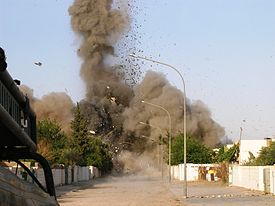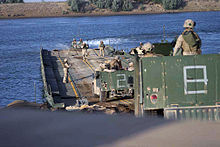- Battle of Al Qaim
-
Operation Matador (Iraq) Part of the Iraq War 
A large weapons cache in New Ubaydi is destroyedDate 8 May 2005–19 May 2005 Location Ubaydi (near Al Qaim), Al-Anbar Result U.S. Tactical Victory Belligerents  United States
United StatesIraqi insurgents Commanders and leaders  Col. S.W. Davis
Col. S.W. Davis Abu Musab al-Zarqawi
Abu Musab al-ZarqawiStrength 1,000 unknown Casualties and losses 9 KIA,40 WIA [1] 125+ insurgents killed Battles and operations
of the Al Anbar CampaignFallujah killings – 1st Ramadan – Spring 2004 (1st Fallujah – 1st Ramadi – Husaybah) – 2nd Fallujah – Abu Ghraib – Sayeed (Al Qaim – Hit – Haditha – Steel Curtain) – Haditha Incident – 2nd Ramadi – Ramadan 2006 – Al Majid – Alljah – Donkey Island – 2008 AQI Offensive – Abu Kamal – 2009 AQI Offensive
The Battle of Al Qaim (code-named Operation Matador) was a military offensive conducted by the United States Marine Corps, against insurgent positions in Iraq's northwestern Anbar province, which ran from 8 May 2005 to 19 May 2005. It was focused on eliminating insurgents and foreign fighters in a region known as a smuggling route and a sanctuary for foreign fighters [2].
Contents
Details
Marines crossed the Euphrates using a ribbon bridge
In mid-May 2005, Task Force 3/2 and elements of Task Force 3/25 (3rd Battalion/2nd Marines, 3rd Battalion/25th Marines, 4th Assault Amphibian Bn, 2nd Light Armored Reconnaissance Bn,B Co 4th Combat Engineer Bn) conducted a sweep of an insurgent-held area near the Syrian border. 814th Engineer Company (MRB) led the initial offensive; breaching the river obstacle with a ribbon float bridge while conducting concurrent rafting. It lasted eleven days, during which the U.S. troops killed more than 125 suspected insurgents and captured 39 others. The Marines captured and/or destroyed many weapon caches and suffered 9 killed in action and 40 wounded in action. Notable among these casualties was a squad from 1st Platoon, Lima Company 3rd Battalion, 25th Marines which had all of its members killed or wounded, mostly while embarked in an AAV that was struck by an IED.[3].
Many of the insurgents encountered were not wearing uniforms, and in some cases were wearing protective vests. Furthermore coalition officials noted that the training, tactics and organization displayed by the insurgents battled in the Syrian desert exceeded that which had been seen in other engagements further east, with only the exception of the former members of the Fedayeen (that comprised a large portion of insurgents fought by the Coalition in Operation Vigilant Resolve.) Thus it is plausible to believe that the Fedayeen made a large portion of the insurgents fought in Matador.
Additionally, the Marines in Matador did not have sufficient numbers to setup a permanent garrison in Al-Qa'im and the other insurgent held towns and withdrew as a result. Consequently as soon as they left guerilla fighters were back in the towns and reestablished control over the town.[4] Insurgents continued presence in the Syrian desert meant that the Syrian border would remain a viable route for smuggling military equipment used by the insurgency .The engagement could loosely be described as a running battle, with the heaviest fighting taking place in urban environments located in Ubaydi, Arabi, and Al-Qa'im, all are cities in the insurgent dominated Al Anbar Governorate[5]. It was followed by Operation Squeeze Play.
See also
Notes
- ^ Period Details
- ^ Miles, 10 May 2005
- ^ Knickmeyer, Ellen* (11 May 2005). "Demise of a hard-fighting squad: Marines who survived ambush are killed, wounded in blast". Washington Post. http://www.msnbc.msn.com/id/7823375/. Retrieved 6 July 2006.
- ^ Knickmeyer, Ellen (16 May 2005). ""Military Offensive in Iraq"Iraq". The Newshour. PBS. http://www.pbs.org/newshour/bb/middle_east/jan-june05/iraq_5-16.html. Retrieved 6 July 2006.
- ^ Knickmeyer, Ellen (15 May 2005). "Looking for Battle, Marines Find That Foes Have Fled-Hunt for Foreign Insurgents Proves Frustrating but Deadly". The Washington Post. http://www.washingtonpost.com/wp-dyn/content/article/2005/05/15/AR2005051500785_pf.html. Retrieved 6 July 2006.
- *Ellen Knickmeyer is the Baghdad bureau chief for the Washington Post and an embedded reporter in Iraq.
References
- Miles, Donna (10 May 2005). "Operation Matador Helping Flush Insurgents From Western Iraq". DefenseLINK News. U.S. Department of Defense. http://www.defense.gov/news/newsarticle.aspx?id=31688. Retrieved 17 July 2006.
External links
- Flower, Kevin; Dulami, Enes; and Kianne Sadeq (14 May 2005). "Hunt for insurgents near Syria ends, More than 125 insurgents, nine Marines dead". CNN. http://www.cnn.com/2005/WORLD/meast/05/14/iraq.main/index.html. Retrieved 17 July 2006.
Prior events Disarmament crisis · WMD claims · Rationale · Popular opinion · Public relations · February interview · Biological weapons
Invasion Multi-National Force · Timeline · Battle of Nasiriyah · Invasion of Baghdad · Debecka Pass · Firdos Square statue · Mission Accomplished Speech
Occupation Military operations Coalition Provisional Authority · Iraq Interim Governing Council · Insurgency · Human rights · Civil war · Execution of Saddam Hussein · U.S. troop withdrawal · Insurgent attacks · Aircraft losses
Opinions Opposition · Protests · Criticism · Legitimacy · United Nations · International community · Associated people
Controversy Mahmudiyah killings · Blackwater Baghdad shootings · Haditha killings · Ishaqi incident · Mukaradeeb wedding party massacre · Baghdad airstrike · Abu Ghraib prisoner abuse · Iraq War documents leak · Baghdad Museum looting
Aftermath Refugees · Duelfer Report · Damage to Baghdad · Aid and Investment · Economic reform · Financial cost · Casualties · Chilcot Inquiry
Timeline Iraq War at Wikinews · Commons Categories:- Battles of the Iraq War involving the United States
- Battles of the Iraq War in 2005
- Urban warfare
- United States Marine Corps in the Iraq War
Wikimedia Foundation. 2010.

